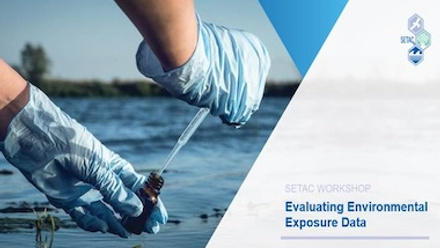On Target at NonTarget 2022
Lee Ferguson, Elin Ulrich, Heinz Singer and Julianne Hollender, NonTarget 2022 Organizing Committee
While temperatures fluctuated from 55–100 degrees Fahrenheit (13–40° C) and a tornado brewed on the first day of the Nontarget Analysis for Environmental Assessment SETAC North America Focused Topic Meeting (NonTarget 2022), the science was hot for 244 environmental chemists from more than 28 countries around the globe, who convened for one week in May in Durham North Carolina.
If you’d like to learn about the topic, check out the SETAC Technical Issue Paper “Nontarget Analysis of Organic Chemicals in the Environment.”
The meeting was the second convention of environmental scientists on the topic following the inaugural event in Ascona, Switzerland, in 2016. The meeting had been much anticipated since 2020 but was delayed due to the global pandemic. Participants were thrilled to get a chance to collaborate and discuss updates in the field. Because nontarget analysis (NTA) is a rapidly evolving technique, communication among practitioners is essential to keep abreast of the advances in the field. The committee was intent on facilitating that communication while ensuring an inclusive meeting. A streaming program was devised to allow online participation, serving over 86 virtual participants.
The meeting kickoff was a plenary lecture by Julianne Hollender, Swiss Federal Institute of Aquatic Science and Technology – Eawag, who talked about developments in instrumentation, workflows and applications since 2016. The days were filled with three plenary lectures, eight keynotes for topical sessions followed by oral platform presentations, as well as four days of poster presentations that were available in person and online. Additionally, the meeting included four interactive sessions on harmonization, workflows, and per- and polyfluoroalkyl substances (PFAS), facilitated using interactive posters, breakout discussions and tool demonstrations as seen in the meeting program and abstract book. For a mid-week excursion, meeting participants enjoyed a stroll at Duke Gardens to center themselves with nature, followed by a reception at Duke University’s Nasher Museum for artistic inspiration. To wrap up the meeting, Lee Ferguson, Duke University and co-chair of the program committee, summarized lessons learned by highlighting key talks and messages.
Lessons Learned- Data processing tools and molecular databases for NTA are becoming mature (Sebastian Böcker, University of Jena)
- Performance evaluation of NTA methods is critical for harmonization and reproducibility – we still have a way to go (Martin Krauss, UFZ – Helmholtz Centre for Environmental Research)
- The intersection of NTA and exposomics bears fruit for human health protection (Doug Walker, Mt. Sinai School of Medicine)
- Integration of high-throughput mechanistic bioassays with NTA provides a route to identifying “causative stressors” (Marja Lamoree, Vrije Universitei Amsterdam)
- NTA is a powerful tool for elucidating environmental processes, when used properly (Tom Young, University of California – Davis)
- The complexities of PFAS chemistries are vast, and high-resolution mass spectrometry (HRMS) has been critical for mapping the extent of this chemical space (Jennifer Guelfo, Texas Tech University)
- Industrial pollution sources are everywhere, and environmental forensics allow new insights for scientific and regulatory action (Mark Strynar, U.S. Environmental Protection Agency)
- Cutting edge instrumental developments improve our capabilities for contaminant identification and (semi)quantitation (Erin Baker, North Carolina State University)
- NTA is moving from a qualitative tool to (semi)quantitative capabilities
- Application of NTA should be customized for the application – it is often not necessary to identify everything in your sample
- Data science and workflow development remains a primary frontier for advancing NTA – chem-informatic methods are improving
- HRMS instrument capabilities may be reaching a plateau, but how do we further illuminate the “dark matter”
- Reproducibility is still a major issue – compound detection remains somewhat stochastic across workflows
- We should not let perfect be the enemy of good-enough – outstanding science can be done with imperfect methods
Before everyone adjourned the winners of the best student poster award were announced:
Third Place: Rebecca Beres, North Carolina State University, “Evaluating Lipidomic Alterations in Exosomes to Explore Human Health Differences”
Second Place: Jessie Chappel, NCSU, “A Novel Approach to Evaluating Disease Risk Through the Incorporation of Lipidomic Data”
First Place: Haoqi (Nina) Zhao, University of Washington, “Identification and Environmental Occurrence of the Ozonation Transformation Products of Tire Rubber Antioxidant 6PPD”
If you missed the meeting but are intrigued now, you can register to access recordings and posters online, along with other registrants, until 22 August.
A survey of meeting participants indicates they really enjoyed the intimacy of a small meeting focused on a specific topic. Respondents suggested that a meeting on NTA should be organized once every two to three years and possibly alternate between Europe and North America. Virtual participants liked having the option to engage remotely although they wished for streamed access to the interactive sessions. All told, the meeting was on target!
Acknowledgment: The meeting organizers would like to thank the meeting sponsors, the scientific committee and the social committee for all their efforts without which the meeting would not have been as successful as it was.
Disclaimer: The views expressed in this article are those of the author(s) and do not necessarily represent the views or the policies of the U.S. Environmental Protection Agency.
Author's contact information: Elin Ulrich, [email protected]




